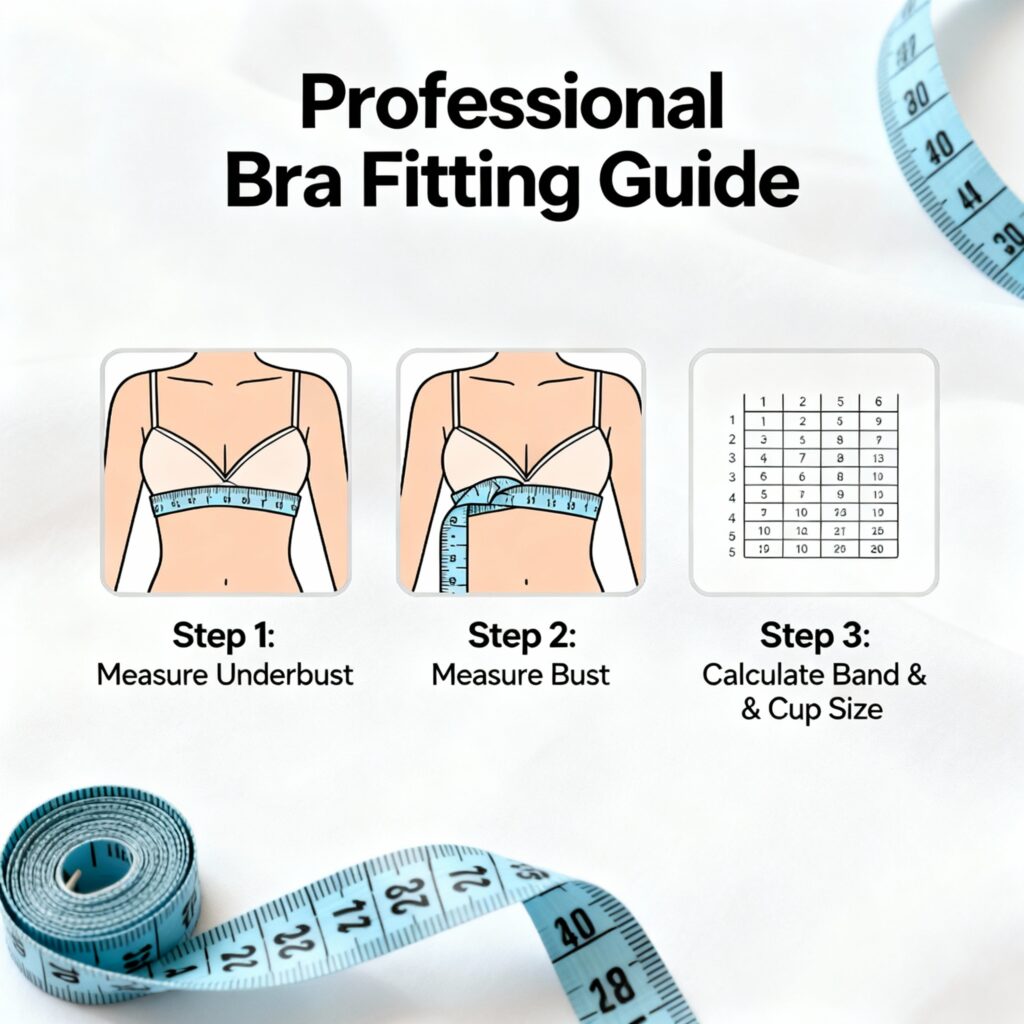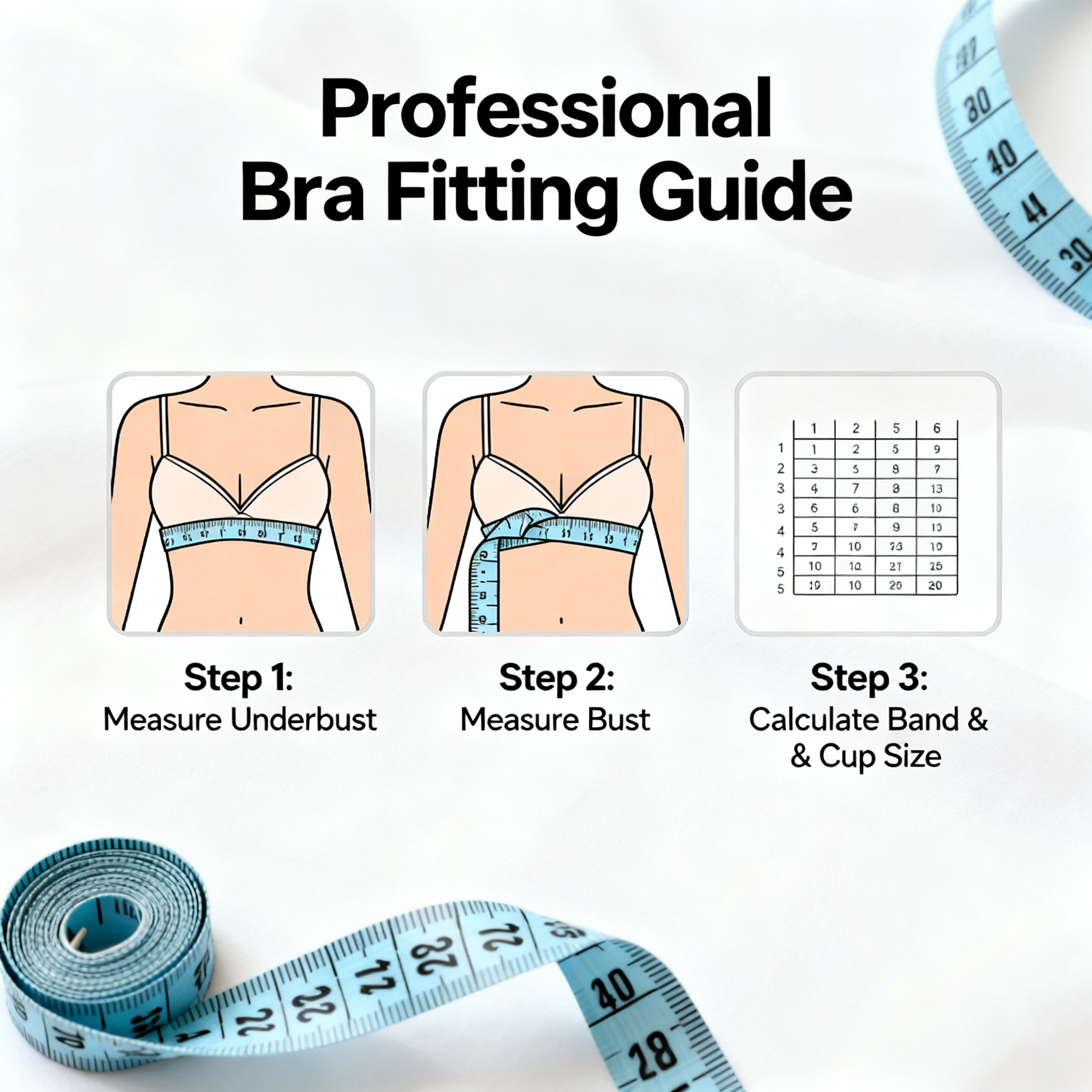
Professional Techniques for Perfect Support
Based on the latest research from certified bra fitting professionals and scientific studies, only 56.4% of women wear the correct bra size. This comprehensive guide incorporates cutting-edge professional techniques used by certified fitters, recent advances in AI-powered fitting technology, and evidence-based methods that outperform traditional tape measure approaches by up to 3 times in accuracy.
Understanding the Modern Approach to Bra Fitting
Professional bra fitting has evolved significantly beyond the outdated “add 4 inches” method that originated in the 1930s. Current research from the University of Portsmouth demonstrates that traditional tape measure methods overestimate band size in 76% of women and underestimate cup size in 84%. Today’s certified fitters use a comprehensive 5-step professional assessment criteria that considers the under-band, cup fit, underwire placement, strap positioning, and overall support dynamics.
The modern fitting philosophy recognizes that bra size is not static – it changes with weight fluctuations, hormonal cycles, age, and even time of day. Professional fitters now emphasize dynamic fit assessment, observing how bras perform during movement and different postures rather than relying solely on static measurements.
The 5-Step Professional Measurement Process
Step 1: Under-Band Measurement Technique
The foundation of proper bra fitting begins with accurate under-band measurement. Professional fitters measure snugly around the ribcage directly under the breast tissue at the inframammary fold. This measurement should be taken while breathing normally, with the tape measure sitting parallel to the ground.
Key Professional Tips:
- Use firm but not tight tension – the tape should not indent the skin significantly
- Ensure the tape stays level all around the torso
- Take the measurement during normal exhalation
- Round to the nearest even number for band size
Step 2: Over-Bust Measurement for Cup Sizing
The over-bust measurement determines cup volume by measuring around the fullest part of the bust while wearing a well-fitting, non-padded bra. Professional fitters emphasize that this measurement alone doesn’t determine cup size – it must be considered in relation to band size and breast shape.
Professional Technique:
- Arms should rest naturally at sides
- Use light tension – the tape should just kiss the skin
- Ensure tape remains parallel to ground
- Measure at the apex (fullest point) of the bust
Step 3: Advanced Fit Assessment Indicators
Modern professional fitting goes beyond basic measurements to assess multiple fit indicators simultaneously. Certified fitters evaluate band position, cup coverage, underwire placement, and dynamic support.
Band Position Diagnostics:
- Band should sit parallel to ground both front and back
- Should not ride up during normal movement
- 80% of support should come from the band, not the straps
- Start on loosest hook setting for new bras
Cup Fit Evaluation:
- No spillage over the cup edges (quadboob effect)
- No gapping or wrinkling in the cup
- Breast tissue should be fully encompassed within the wire perimeter
- Natural breast shape should be enhanced, not flattened
Professional Underwire Placement and Gore Positioning
Underwire Placement Fundamentals
Proper underwire placement is crucial for comfort and support. The underwire should completely encircle the breast tissue without sitting on any breast tissue itself. Professional fitters check that underwires follow the natural inframammary fold (breast root) from the sternum to under the arm.
Signs of Proper Underwire Placement:
- Wire sits flat against the ribcage
- No poking or digging sensations
- Wire doesn’t extend beyond breast tissue into the armpit
- Complete support of breast tissue without compression
Center Gore (Bridge) Positioning
The center gore – the triangular panel between the cups – provides critical structural support and breast separation. In a properly fitting underwire bra, the gore should tack (lie flat) against the sternum. When the gore doesn’t tack, it typically indicates that cup size is too small or the wrong shape for the breast type.
Gore Fit Indicators:
- Narrow gores work best for close-set breasts (less than 2 fingers apart)
- Wide gores suit wider-set breasts (more than 2 fingers apart)
- Gore height affects coverage and support level
- Exception: Wireless and minimizer bras may not tack normally
Sister Sizing Calculations and Conversions
Sister sizing represents one of the most valuable tools in professional bra fitting, allowing for precise fit adjustments while maintaining the same cup volume. The principle works because cup size is relative to band size – as band size changes, cup size must adjust proportionally to maintain the same volume.
Sister Sizing Formula
The fundamental rule: For each band size you go down, go up one cup size. For each band size you go up, go down one cup size.
Examples:
- 34C = 32D = 36B (same cup volume)
- 36DD = 34E = 38D (same cup volume)
- 32B = 30C = 34A (same cup volume)
When to Use Sister Sizing
Professional fitters recommend sister sizing in several scenarios:
- Perfect cup fit, but band too tight/loose: Change both band and cup size
- Size unavailable: Find alternative with same cup volume
- Brand differences: Some brands run large/small in specific measurements
- Between sizes: Fine-tune fit for optimal comfort
International Size Conversions
Global bra shopping requires understanding different sizing systems. European sizes use centimeters for band measurement, while UK/US systems use inches. Cup progressions also vary significantly between countries.
Key Conversion Principles
Band Size Conversions:
- EU to UK/US: Subtract 10 (EU 75 = UK/US 34)
- French sizing: Typically 15 sizes larger than EU
- Australian: Uses dress size numbering system
Cup Size Variations:
- UK vs US: Diverge after D cup (UK E = US DD)
- European: Generally matches UK lettering
- Japanese: Often uses combined sizing (70B/C)
Advanced Breast Shape Considerations
Projection vs. Shallow Breast Shapes
Understanding breast projection is crucial for selecting appropriate bra styles. Projection describes how far breast tissue extends from the chest wall, independent of actual cup size.
Shallow Breasts Characteristics:
- Tissue spread over wider chest area
- Often self-supporting
- May experience gapping in traditional bra cups
- Better suited to minimizer or sports bra styles
Projected Breasts Characteristics:
- Tissue concentrated in smaller root area
- Extend further forward from chest
- Require deeper cup construction
- May cause gore floating in shallow-cup bras
Fullness Distribution Patterns
Professional fitters assess upper vs. lower fullness to recommend appropriate bra styles. This assessment helps predict how different cup constructions will perform.
Upper Fullness (Full on Top):
- Tissue concentration above nipple line
- Suited to full-cup or high-coverage styles
- May experience spillage in low-cut styles
Lower Fullness (Full on Bottom):
- Most tissue below nipple line
- Works well with push-up or plunge styles
- May experience gapping at cup tops
Hook Progression and Band Elasticity
Optimal Hook Usage Strategy
Professional fitters emphasize starting new bras on the loosest hook setting to maximize bra lifespan. As elastic naturally stretches with wear and washing, you progress to tighter hooks to maintain proper fit.
Hook Progression Timeline:
- New bra: Loosest hook (should feel snug but comfortable)
- 3-6 months: Middle hook as band stretches
- 6+ months: Tightest hook as elastic continues to relax
- Replace bra: When tightest hook becomes loose
Band Support Dynamics
The band provides 80% of bra support, making proper band fit critical for overall function. When bands are too loose, straps compensate by carrying excess weight, leading to shoulder pain and strap slippage.
Signs of Optimal Band Fit:
- Sits level and parallel to ground
- Doesn’t ride up during normal movement
- Can fit two fingers under band with slight resistance
- Provides support without excessive tightness
Troubleshooting Common Fit Issues
“Double Boob” and Spillage Solutions
Cup spillage creates the unflattering “quadboob” effect and indicates insufficient cup volume. This issue often results from focusing solely on band size while ignoring cup requirements.
Professional Solutions:
- Increase cup size by one or more letters
- Use swoop and scoop technique to properly position breast tissue
- Consider full-coverage or balconette styles for better containment
- Check that underwires fully encompass all breast tissue
Back Bulge and Band Tightness Remedies
Back bulge can result from either band too tight or band sitting in wrong position. Professional assessment distinguishes between these causes to recommend appropriate solutions.
Assessment and Solutions:
- If band too tight: Size up in band, down in cup to maintain volume
- If position issue: Adjust band placement to natural waist
- If flesh displacement: Consider smoothing or T-shirt bra styles
- Ensure band sits parallel to ground all around torso
Strap Slippage and Digging Problems
Strap issues typically indicate inadequate band support rather than strap problems themselves. When bands carry insufficient support load, straps overcompensate.
Professional Remedies:
- Tighten band first before adjusting straps
- Consider racerback or convertible strap options
- Check for proper strap width for shoulder comfort
- Ensure straps provide only 20% of total support
2025 Technology and Innovations
AI-Powered Fitting Solutions
The lingerie industry increasingly incorporates artificial intelligence and 3D scanning technology for precise sizing. Companies like Brarista report 3 times greater accuracy than traditional tape measures using AI-driven assessment.
Current Technologies:
- Computer vision analysis of body shape and movement
- Virtual try-on experiences using augmented reality
- Fit prediction algorithms based on thousands of fitting records
- 3D body scanning for custom measurements
Smart Fabric Innovations
Advanced materials revolutionize bra construction with 3D knitting technology creating seamless, single-piece garments. These innovations eliminate irritating seams while providing targeted compression mapping for optimal support distribution.
2025 Material Advances:
- Phase-changing materials for temperature regulation
- Compression fabrics with strategic elasticity
- Moisture-wicking and antibacterial properties
- Memory fabrics that adapt to individual body shapes
Professional Maintenance and Care
Extending Bra Lifespan
Proper care significantly impacts bra longevity and fit maintenance. Professional fitting experts recommend rotating between multiple bras to allow elastic recovery between wears.
Care Best Practices:
- Hand wash or use lingerie bags for machine washing
- Air dry to prevent elastic breakdown
- Store flat or hanging to maintain cup shape
- Replace every 6-12 months depending on wear frequency
When to Seek Professional Fitting
While self-assessment techniques help, certain situations warrant professional fitting consultation:
- Significant weight changes (10+ pounds)
- Pregnancy or postpartum body changes
- Persistent fit problems despite adjustments
- Post-surgical fitting requirements
- First-time proper fitting for optimal baseline
Conclusion
Professional bra fitting in 2025 represents a scientific, evidence-based approach that prioritizes individual body characteristics over outdated measurement formulas. The 5-step assessment process, combined with understanding of breast shape variations, sister sizing principles, and advanced fit indicators, provides the foundation for achieving optimal support and comfort.
Modern fitting acknowledges that perfect fit requires ongoing assessment as bodies change throughout life. Whether utilizing AI-powered fitting technology or traditional professional expertise, the goal remains consistent: providing 80% support from the band, appropriate cup volume for breast shape, and comfortable all-day wear that enhances rather than restricts daily activities.
The investment in proper professional fitting or thorough self-assessment using these evidence-based techniques pays dividends in improved posture, reduced shoulder and back pain, enhanced confidence, and better clothing fit. As the industry continues evolving with smart fabrics and personalized fitting algorithms, the fundamental principles of proper support, appropriate sizing, and individual shape consideration remain the cornerstone of exceptional bra fit.
This guide incorporates research from certified bra fitting professionals, academic studies, and the latest industry innovations as of October 2025. For personalized fitting advice, consult with a certified bra fitting specialist.
